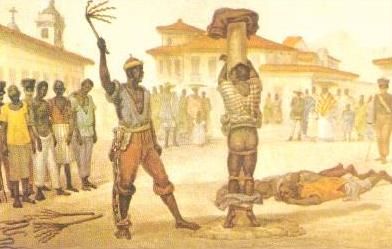Flogging - Method of Punishment
During the Golden Age of Piracy in the 17th and 18th century, punishment at sea was commonly used for enforcing rules and subduing prisoners both on pirate ships and on military ships of many nations. Among them all, the most used was the technique of flogging in which offending crew member, captive or slave was tied to the mast (or hung in the air by the hands or leg angles from the mast) and flogged mercilessly.
Whipping the backs of sailors was very greatly popularized on the English military vessels where sailors even managed to think of it as a character-building tradition, they took pride in the fact that if you want to be a sailor in British Royal Navy you have to be strong, durable and be able to tolerate pain. The flogging techniques that were used there were separated into two types. Quick and immediate punishment by the single-tailed whip (often named by sailors “rope’s end” or “starter”) was used for smaller indiscretions and management of discipline. Punishment for severe offenders was much more painful and involved one of two whipping techniques. First one was mass whipping during “knittles” or “running the gauntlet” where the offender was forced to walk between the two lines of sailors who whipped his back as he walked. The second and more painful one were the floggings using special “Cat o' nine tails” or “captain’s daughter” whip. This short whip features nine knotted strands of rope that are connected to the main handle. Official punishment with Cat o' nine tails was performed on the main deck of the ship, with all crewmen being present and the prisoner being brought to the flogging by marines with fixed bayonets.
In addition to the whipping measures that Captain could immediately invoke on the sea, the most brutal form of corporal punishment in Royal British Navy happened when ships were stationed in ports. There, prisoners who faced the heaviest accusations by the officers (such as sedition, mutiny and extreme forms of cowardice) were put to the “round of fleet” flogging ceremony in which the sentenced number of lashes that prisoner had to endure was divided by the number of Royal Navy ships that were present in port. Then the squad of marines took the prisoner to each ship to be flogged, so that crew of all ships could see the consequences of his actions.
The number of lashings offender received in the Royal Navy could even reach 200 to 500, which is enough to kill a man if officers who performed the whipping were not careful. To prevent fatalities, sentences were usually performed over weeks and months, depending on how much pain and injury a prisoner could take. After each session of flogging prisoners were forced to endure additional pain as their wounds were cleaned by salty sea water or brine. This practice gave birth to the popular expression “rubbing salt into wounds”.
Even though modern pirate lore often mentions flogging as their common form of punishment at sea, but in reality they did not use it much. This happened because many pirate crew members came from military or navy where they became dissatisfied with flogging. Pirate contracts that were accepted by crew members on many pirate ships explicitly mentioned that flogging will not be used to punish pirates who broke rules or rocked the discipline on the ship. However some more violent pirate bands did use whipping to punish their captives, and several crews even incorporated it as an internal punishment. Out of for surviving pirate contracts from the Golden Age of Piracy, only one mentioned flogging. This was found in the articles of the English pirate captain John Phillips who was active between 1721 and 1724. In it says “That Man that shall strike another whilst these Articles are in force shall receive Moses’s Law on the bare Back. “ In this case, Moses’s Law was a particularly painful type of whip that featured 40 strands of knotted strand on its tail.
